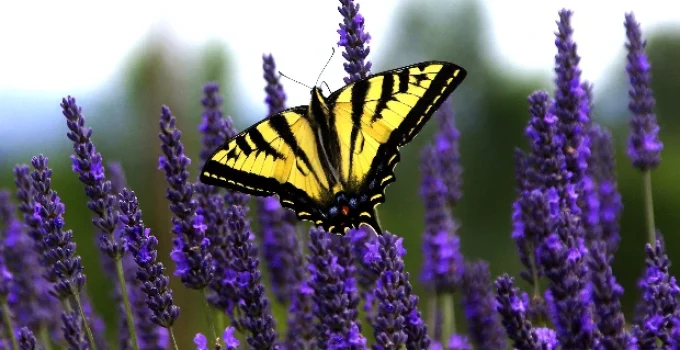Where Do Butterflies Go in the Winter?
Answer at a Glance: In winter, most butterflies either migrate to warmer climates or hibernate in a hidden place. Different species survive cold weather in different ways. Some fly thousands of miles to escape freezing temperatures, while others wait out the winter as eggs, caterpillars, chrysalises, or even adult butterflies tucked away in shelter.
🔎 Dive Deeper
- How Do Butterflies Survive the Winter?
- Which Butterflies Migrate South?
- Can Butterflies Hibernate?
- What Stage of Life Are Butterflies in During Winter?
- Why Can’t Butterflies Survive Cold Weather?
- 🎯 Final Thoughts
- 📚 References
How Do Butterflies Survive the Winter?
Butterflies are cold-blooded insects. This means they can’t regulate their body temperature, so they can’t stay active in cold weather. As temperatures drop in the fall, butterflies must choose one of two survival strategies:
- Migration – Flying south to warmer areas.
- Hibernation – Going dormant in a protected place until spring.
Without one of these options, most butterflies wouldn’t survive the cold.
📊 Fun Fact: Butterflies usually need a body temperature of at least 85°F (29°C) to fly. Below 55°F (13°C), they become sluggish or stop moving entirely. [1]
Which Butterflies Migrate South?
Some butterflies migrate long distances each year to avoid winter weather. The most famous example is the monarch butterfly.
- Monarchs in North America migrate up to 3,000 miles from Canada or the northern U.S. to central Mexico.
- They gather by the millions in mountain forests and rest through the winter.
- In spring, they begin the journey back north, laying eggs along the way.
Other migratory butterflies include:
- Painted ladies
- Cloudless sulphurs
- Red admirals
These migrations aren’t as long as the monarch’s, but they still help the butterflies find warmth and food.
Can Butterflies Hibernate?
Yes! Many butterflies hibernate instead of migrating.
They find safe, sheltered places like:
- Hollow logs
- Loose bark
- Cracks in buildings
- Leaf piles or tree cavities
During hibernation (called diapause in insects), their bodies slow down. They stop eating and moving, and they wait for warmer temperatures.
❄️ Some butterflies even produce a kind of natural antifreeze in their bodies to keep from freezing solid. [2]
What Stage of Life Are Butterflies in During Winter?
Butterflies have four life stages:
- Egg
- Caterpillar (larva)
- Chrysalis (pupa)
- Adult butterfly
Depending on the species, they may hibernate in any of these stages:
| Stage | Examples of Species That Hibernate in This Stage |
|---|---|
| Egg | Baltimore checkerspot |
| Caterpillar | Viceroy, mourning cloak |
| Chrysalis | Swallowtails, some sulfurs |
| Adult butterfly | Mourning cloak, question mark, comma |
This is why you sometimes see butterflies flying very early in spring—they hibernated as adults and woke up when it warmed up!
Why Can’t Butterflies Survive Cold Weather?
Butterflies are delicate. Their bodies and wings are made of thin membranes and soft tissues, which:
- Can freeze in low temperatures
- Lose moisture easily in cold, dry air
- Need sunlight to warm up their flight muscles
Also, cold weather means fewer flowers, so migrating or hibernating helps them avoid starvation in winter.
🌍 Interesting Stat: Monarch butterfly populations have dropped by over 80% in the past 20 years, partly due to habitat loss on their wintering grounds. [3]
🎯 Final Thoughts
Butterflies are more than just beautiful insects—they’re smart survivors. Whether they fly thousands of miles to find warmth or tuck themselves into a crack in a tree, butterflies have developed amazing ways to survive the winter.
So next time you wonder where they’ve all gone in the cold months, just remember: some are resting in faraway forests, while others are hidden right in your backyard, waiting for spring.
📚 References
- Scott, J. A. (1986). The Butterflies of North America. Stanford University Press.
- Duman, J.G. (2001). “Antifreeze and ice nucleator proteins in terrestrial arthropods.” Annual Review of Physiology, https://doi.org/10.1146/annurev.physiol.63.1.327
- Xerces Society. “Monarch Overwintering Populations in Mexico.” https://xerces.org/monarchs
- University of Minnesota Monarch Lab. “Migration and Overwintering.” https://monarchlab.org
📌Learn More About Insects & Arachnids
- Why Do Crickets Chirp at Night
- What’s the Life Cycle of a Dragonfly
- Why Do Ants March in a Line
- Why Do Fireflies Glow at Night?
- What Is the Difference Between Lady Bug and Lady Beetle?
